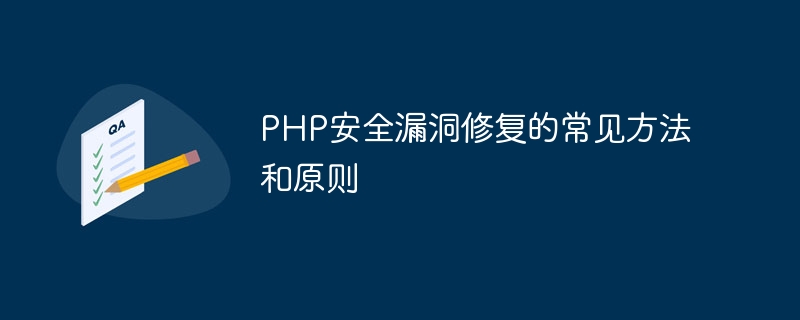Home >Backend Development >PHP Tutorial >Common methods and principles for fixing PHP security vulnerabilities
Common methods and principles for fixing PHP security vulnerabilities
- PHPzOriginal
- 2023-08-10 11:49:412446browse

Common methods and principles for repairing PHP security vulnerabilities
With the rapid development of the Internet, website security issues have become increasingly prominent. As one of the most widely used programming languages, the security of PHP has also attracted much attention. This article will introduce common methods and principles for PHP security vulnerability repair, and illustrate it through code examples.
- Input Validation and Filtering
Input validation is an important part of fixing security vulnerabilities in PHP applications. After receiving user input, these inputs should be validated and filtered to ensure that the data received meets the requirements. With the right filtering, common security vulnerabilities such as SQL injection attacks and cross-site scripting attacks (XSS) can be prevented.
Below is a simple example showing how to use PHP built-in functions for input validation and filtering.
$username = $_POST['username']; // 接收用户输入的用户名
// 对用户名进行验证和过滤
if (preg_match('/^[a-zA-Z0-9]+$/', $username)) {
// 用户名符合要求,继续处理
} else {
// 用户名不符合要求,给出错误提示
echo "请输入正确的用户名";
}- Prevent SQL injection attacks
SQL injection attacks refer to attackers modifying the SQL statements entered by users to obtain, modify or delete data in the database. To prevent SQL injection attacks, you can use parameterized queries or prepared statements.
The following is an example of using prepared statements:
$username = $_POST['username']; // 接收用户输入的用户名
// 使用预处理语句进行查询
$stmt = $pdo->prepare('SELECT * FROM users WHERE username = :username');
$stmt->execute(['username' => $username]);
// 处理查询结果
$result = $stmt->fetchAll(PDO::FETCH_ASSOC);- Preventing cross-site scripting attacks (XSS)
A cross-site scripting attack occurs when an attacker passes Malicious script code is injected into web pages to obtain users' sensitive information or tamper with web page content. To prevent XSS attacks, special characters in user input need to be escaped or filtered.
The following is a simple example that shows how to use PHP built-in functions for XSS protection:
$username = $_POST['username']; // 接收用户输入的用户名 // 对用户名进行HTML转义 $username = htmlspecialchars($username, ENT_QUOTES, 'UTF-8'); // 输出转义后的用户名 echo "欢迎你," . $username;
- File upload security
The file upload function is a common feature of many websites Required functionality, but if not handled correctly, can lead to serious security issues. In order to prevent malicious files from being uploaded, uploaded files need to be verified and filtered. Only specified types are allowed to be uploaded and file sizes are limited.
Here is an example showing how to verify the type and size of a file:
$allowedTypes = ['image/jpeg', 'image/png']; // 允许上传的文件类型
$maxSize = 1024 * 1024; // 允许的最大文件尺寸,这里设置为1MB
$uploadedFile = $_FILES['file']; // 接收上传的文件
// 验证文件类型
if (!in_array($uploadedFile['type'], $allowedTypes)) {
echo "只允许上传JPEG和PNG格式的图片";
exit;
}
// 验证文件尺寸
if ($uploadedFile['size'] > $maxSize) {
echo "文件尺寸不能超过 1MB";
exit;
}
// 处理上传的文件
move_uploaded_file($uploadedFile['tmp_name'], '/path/to/save/file.jpg');To summarize, common methods and principles for PHP security vulnerability fixes cover input validation and Filtering, preventing SQL injection attacks, preventing cross-site scripting attacks, and file upload security. By rationally applying these methods and principles and combining them with actual situations, the security of PHP applications can be improved and the security of user data can be protected.
The above is the detailed content of Common methods and principles for fixing PHP security vulnerabilities. For more information, please follow other related articles on the PHP Chinese website!

